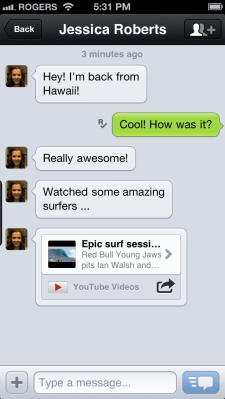Waterloo-based mobile messaging app Kik, while immensely successful in its category, faced a problem: once you’ve nailed cross-platform messaging, and added group features, where do you go from there? Do too much, and you risk watering down the core product, the one that has helped Kik sign up over 30 million registered users who are coming on board at a rate of about 100,000 new user per day. Do too little, and you run the risk of becoming stagnant in an increasingly crowded marketplace.
What Kik founder Ted Livingston and his team came up with is, he believes, the perfect way to both offer up additional features that users are asking for, while keeping the core product pristine for customers who are already extremely satisfied with the experience. The company thinks its new Kik Cards are the way to do that: small, sleek HTML5 applets custom-coded by Kik’s own team that can add games, drawing apps, YouTube videos and potentially much more to a user’s message stream, without becoming an unnecessary distraction for users who don’t want it. Card content shows up in a user’s message stream, and if that user doesn’t have that Card activated on their account, it’s immediately added to their own list once they click on the particular message to view what it contains.
“We think people want a really simple experience on mobile,” Livingston explained in an interview. “We think people want a really simple experience on mobile. We haven’t added a feature to Kik in like a year and a half, since 2011, with group messaging. And everyone has asked ‘So what are you going to do next to differentiate yourself from the other messengers out there,” but I was worried that if we add all this stuff, we’d ruin the product. And over time we saw a lot of people do that.” Instead, Kik wanted a way to add functionality for users who wanted it, while retaining the basic features front-and-center for people who didn’t.
I had to ask whether or not Livingston thought that the implementation as it was might still irritate users. After all, if someone you’re messaging with wants to send you a YouTube video using the YouTube card, there’s no universal off switch to prevent those coming through. But Livingston said that this is different from a one-to-all type broadcast like you get with auto-posted content on Facebook; it has to be sent with intent from one person directly to another, which means the sender is much more likely to truly believe the receiving party wants to see it. Because of this, it also makes Kik Cards a unique new means through which brands can potentially reach new audiences.
The long-term vision for cards is to develop a sales pipeline and work with companies to create branded Cards. For instance, if Disney wanted to promote a new movie, they could create an interactive game Card with Kik, which users would then share with one another, so long as they perceive it as something that actually delivers value.
This could open up a potential revenue stream for Kik, which has tremendous traction but offers its product for free. The app has amassed a massive user base, but now it needs a way to monetize that. Livingston and company have learned from watching Twitter and Facebook experience growing pains as they try to convert free users into financial opportunity, and that’s why they’ve gone this route, with an attempt at keeping the core product uncluttered while also making a platform play. For now, Kik will also have complete control over which Cards appear on the platform, and will in fact also build them to ensure the experience is a good one for users.
“We’re not going to put a banner ad at the bottom, because even if users click it, it’s going to be by mistake. It’s going to be a bad experience for you, it’s going to be a bad experience for us and for everyone,” Livingston said, describing why this is a better monetization route for the app to take. “Here, you can do a great experience right in the app and users can choose to share the ones that they genuinely like and not share the one that they don’t.”
Still, while in theory branded experiences shared one-to-one between users offers more chance to reach a receptive audience than an aimless blast on social networks, it’s a relatively untested marketing concept. Advertisers are hungry for new ways to reach digital audiences, however, and this approach could well be one that delivers higher conversion rates than we’ve otherwise been seeing as brand move from traditional display and print ads to digital and interactive campaigns. And for Kik, shifting focus slightly to differentiate its offering further from things like Facebook Messenger, iMessage and other plays tied to specific platforms should help user growth continue to chart upwards.
On the user side, it seems like there’s much more straightforward value delivered. The key will be ensuring how the signal-to-noise ratio holds up once the Cards area becomes more crowded, and users start to find, discover and use them.
